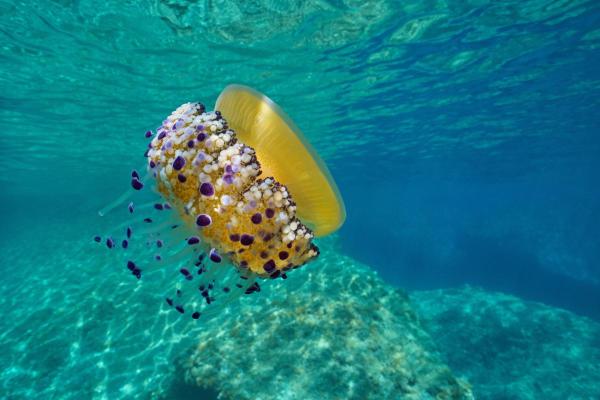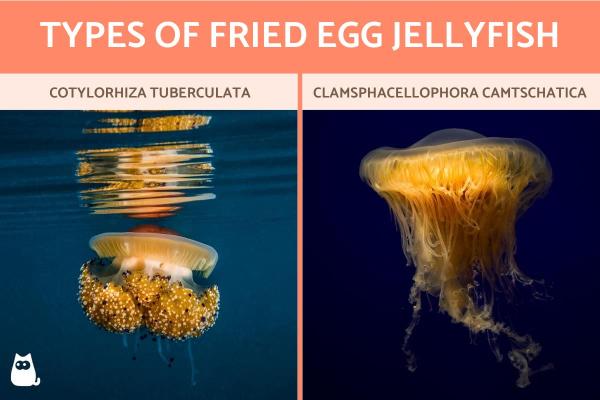Do Fried Egg Jellyfish Sting?


The ocean teems with a diverse array of life, including the mesmerizing -and feared- jellyfish. Among these gelatinous creatures, the fried egg jellyfish is instantly recognizable for its distinctive appearance. While their beauty is undeniable, a common concern for water enthusiasts is the potential for a painful or poisonous sting. Understanding the nature of their sting is crucial for ensuring a safe and enjoyable aquatic experience.
Discover the truth about fried egg jellyfish stings in this AnimalWised article. We explore whether these jellyfish pose a threat to swimmers and provide essential safety tips.
Is fried egg jellyfish poisonous?
The term "fried egg jellyfish" encompasses two distinct species: Cotylorhiza tuberculata and Phacellophora camtschatica. While both share a similar appearance, it's important to understand that they may have different characteristics, including the potential for stinging. Let's examine each species individually.
- Mediterranean Fried Egg Jellyfish (Cotylorhiza tuberculata): this species is known to contain the typical cnidarian toxins, but its venom is usually mild. Contact with this jellyfish can cause itching and a burning sensation, particularly in sensitive individuals, but it is not considered life-threatening.
- Fried Egg Jellyfish (Phacellophora camtschatica): this species does not pose significant danger to humans. It is not highly toxic, and contact with its tentacles typically results in only minor reactions, such as slight skin irritation in sensitive individuals.
Overall, while they may cause minor discomfort, fried egg jellyfish are not poisonous to the extent that poses a serious health risk to most people.
Learn about the world's most dangerous jellyfish in this other article.

Does fried egg jellyfish sting?
Fried egg jellyfish, like other jellyfish, belong to the phylum Cnidaria, which is characterized by the presence of specialized cells called cnidocytes. These cells contain structures capable of piercing skin or other tissues to inject toxins. This venom helps the jellyfish capture prey and defend itself, as these creatures are carnivorous. The potency of the venom varies widely among jellyfish species.
Fried egg jellyfish, which include Cotylorhiza tuberculata and Phacellophora camtschatica, do possess cnidocytes and can sting. However, their venom is not particularly harmful to humans.
For these jellyfish, the sting is designed to immobilize prey, but in people, it typically causes only minor reactions such as itching or a mild burning sensation.
Curious about the different parts of a jellyfish and how they function? Dive deeper into the anatomy of these fascinating creatures in our related article.
What is a fried egg jellyfish sting feel like?
Since many jellyfish pose a serious threat to humans, it's essential for swimmers and divers to be informed about the specific risks associated with different species. In regard to both fried egg jellyfish species, this is what we can expect:
- The Mediterranean fried egg jellyfish (Cotylorhiza tuberculata), which is common in the Mediterranean, typically poses little threat to humans. Despite having tentacles filled with nematocysts, their stings are generally mild and often barely noticeable to most people. There may be slight redness or a rash in the area where the sting occurred, though this is usually not severe.
- Similarly, the fried egg jellyfish (Phacellophora camtschatica) also contains nematocysts but is not dangerous to humans. Stings from this species usually cause only minor skin irritation or a slight tingling sensation, which typically resolves quickly without any serious effects.
In both cases, any discomfort or burning sensation is generally short-lived and fades relatively quickly after leaving the water. Sensitive individuals may experience a bit more irritation, but even for them, the sting is rarely severe.
Ever wondered what jellyfish eat, how they hunt, and other intriguing details? Discover all this and more in our related article.
How do you treat a jellyfish egg sting?
If you find yourself stung by a fried egg jellyfish and experience any reaction, whether from Cotylorhiza tuberculata or Phacellophora camtschatica, follow these steps to manage the situation:
- Calmly leave the water to prevent further contact with the jellyfish and avoid additional stings.
- Do not rub the affected area, as this can trigger any remaining nematocysts (stinging cells) and cause them to release more toxins.
- Gently rinse the affected area with seawater, being careful not to rub.
- Use a clean object, such as tweezers, to carefully remove any tentacles from the skin. Avoid using your hands directly to prevent further stings.
- After removing the tentacles, apply a warm water compress to the area to help relieve discomfort.
If symptoms worsen or new symptoms appear, promptly seek medical evaluation at a nearby health facility.
Before you go, be sure to check out our other article on jellyfish stings and find out which species are the least dangerous.
If you want to read similar articles to Do Fried Egg Jellyfish Sting?, we recommend you visit our Facts about the animal kingdom category.
- Animal Diversity Web. (2020). Available at: https://animaldiversity.org/
- Mayo Clinic. (2024). Jellyfish sting . Available at: https://www.mayoclinic.org/es/diseases-conditions/jellyfish-stings/diagnosis-treatment/drc-20353290






